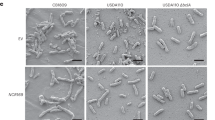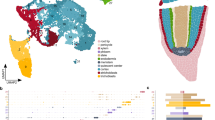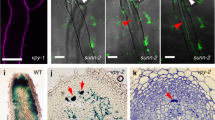Abstract
Symbiotic nitrogen-fixing root nodules on legumes are founded by root cortical cells that de-differentiate and restart cell division to establish nodule primordia. Bacterial microsymbionts invade these primordia through infection threads laid down by the plant and, after endocytosis, membrane-enclosed bacteroids occupy cells in the nitrogen-fixing tissue of functional nodules. The bacteria excrete lipochitin oligosaccharides1,2, triggering a developmental process that is controlled by the plant and can be suppressed. Nodule inception initially relies on cell competence in a narrow infection zone located just behind the growing root tip. Older nodules then regulate the number of nodules on a root system by suppressing the development of nodule primordia3. To identify the regulatory components that act early in nodule induction, we characterized a transposon-tagged Lotus japonicus mutant, nin (for nodule inception), arrested at the stage of bacterial recognition. We show that nin is required for the formation of infection threads and the initiation of primordia. NIN protein has regional similarity to transcription factors, and the predicted DNA-binding/dimerization domain identifies and typifies a consensus motif conserved in plant proteins with a function in nitrogen-controlled development.
This is a preview of subscription content, access via your institution
Access options
Subscribe to this journal
Receive 51 print issues and online access
$199.00 per year
only $3.90 per issue
Buy this article
- Purchase on Springer Link
- Instant access to full article PDF
Prices may be subject to local taxes which are calculated during checkout





Similar content being viewed by others
References
Truchet,G. et al. Sulphated lipo-oligosaccharide signals of Rhizobium meliloti elicit root nodule organogenesis in alfalfa. Nature 351, 670–673 (1991).
Spaink,K. et al. A novel highly unsaturated fatty acid moiety of lipo-oligosaccharide signals determines host specificity of Rhizobium. Nature 354, 125–130 (1991).
Caetano-Anollés,G. & Gresshoff,P. M. Plant genetic control of nodulation. Annu. Rev. Microbiol. 45, 345–382 (1991).
Handberg,K. & Stougaard,J. Lotus japonicus, an autogamous, diploid legume species for classical and molecular genetics. Plant J. 2, 487–496 (1992).
Spaink,H. P., Kondorosi,A. & Hooykaas,P. J. J. (eds) The Rhizobiaceae (Kluwer, Dordrecht, 1998).
Long,S. R. Rhizobium symbiosis: Nod factors in perspective. Plant Cell 8, 1885–1898 (1996).
López-Lara,I. M. et al. Structural identification of the lipo-chitin oligosaccharide nodulation signals of Rhizobium loti. Mol. Microbiol. 15, 627–638 (1995).
Landschulz,W. H., Johnson,P. F. & McKnight,S. L. The leucine zipper: A hypothetical structure common to a new class of DNA binding proteins. Science 240, 1759–1764 (1988).
Ferré-D'Amaré,A. R., Prendergast,G. C., Ziff,E. B. & Burley,S. K. Recognition by Max of its cognate DNA through a dimeric b/HLH/Z domain. Nature 363, 38–45 (1993).
Puyet,A., Ibanez,A. M. & Espinosa,M. Characterisation of the Streptococcus pneumoniae maltosaccharide MalR, a member of the LacI-GalR family of repressors displaying distinctive genetic features. J. Biol. Chem. 268, 25402–25408 (1993).
Silver,P. A. How proteins enter the nucleus. Cell 64, 489–497 (1991).
Plano,G. V. & Winkler,H. H. Identification and initial topological analysis of the Rickettsia prowazekii ATP/ADP translocase. J. Bacteriol. 173, 3389–3396 (1991).
Lehmbeck,J. et al. Sequence of two genes in pea chloroplast DNA coding for 84 and 82 kD polypeptides of the photosystem I complex. Plant Mol. Biol. 7, 3–10 (1986).
Ferris,P. J. & Goodenough,U. W. Mating type in Chlamydomonas is specified by mid, the Minus-dominance gene. Genetics 146, 859–869 (1997).
Ferris,P. J., Pavlovic,C., Fabry,S. & Goodenough,U. W. Rapid evolution of sex-related genes in Chlamydomonas. Proc. Natl Acad. Sci. USA 94, 8634–8639 (1997).
Beck,C. F. & Haring,M. A. Gametic differentiation of Chlamydomonas. Int. Rev. Cytol. 168, 259–302 (1996).
Yokoyama,C. et al. SREBP-1, a basic-helix-loop-helix-leucine zipper protein that controls transcription of the low density lipoprotein receptor gene. Cell 75, 187–197 (1993).
Brown,M. S. & Goldstein,J. L. The SREBP pathway: Regulation of cholesterol metabolism by proteolysis of a membrane-bound transcription factor. Cell 89, 331–340 (1997).
Sakai,J. et al. Molecular identification of the sterol-regulated luminal protease that cleaves SREBPs and controls lipid composition of animal cells. Mol. Cell 2, 505–514 (1998).
Schroeter,E. H., Kisslinger,J. A. & Kopan,R. Notch-1 signalling requires ligand-induced proteolytic release of intracellular domain. Nature 393, 382–386 (1998).
Thykjaer,T., Stiller,J., Handberg,K., Jones,J. & Stougaard,J. The maize transposable element Ac is mobile in the legume Lotus japonicus. Plant Mol. Biol. 27, 981–993 (1995).
Schauser,L. et al. Symbiotic mutants deficient in nodule establishment identified after T-DNA mutagenesis of Lotus japonicus. Mol. Gen. Genet. 259, 414–423 (1998).
Sullivan,J. T. et al. Nodulating strains of Rhizobium loti arise through chromosomal symbiotic gene transfer in the environment. Proc. Natl Acad. Sci. USA 92, 8985–8989 (1995).
Boivin,C. et al. Rhizobium meliloti genes encoding catabolism of trigonelline are induced under symbiotic conditions. Plant Cell 2, 1157–1170 (1990).
Earp,D. J., Lowe,B. & Baker,B. Amplification of genomic sequences flanking transposable elements in host and heterologous plants: a tool for transposon tagging and genome characterization. Nucleic Acids Res. 18, 3271–3279 (1990).
Papadopoulou,K., Roussis,A. & Katinakis,P. Phaseolus ENOD40 is involved in symbiotic and non-symbiotic organogenetic processes: expression during nodule and lateral root development. Plant Mol. Biol. 30, 403–417 (1996).
Acknowledgements
We thank C. Ronson for supplying the M. loti nodC mutant; H. Spaink for the purified M. loti lipochitin oligosaccharide; and A. Nielsen and S. Rye for assistance. This research was supported by the Danish Biotechnology Programme and the SJVF Whole Plant Physiology Initiative. J. Stiller was supported by the Danish Science Research Councils postdoc programme, and A.R. by the EU-TMR programme.
Author information
Authors and Affiliations
Corresponding author
Rights and permissions
About this article
Cite this article
Schauser, L., Roussis, A., Stiller, J. et al. A plant regulator controlling development of symbiotic root nodules. Nature 402, 191–195 (1999). https://doi.org/10.1038/46058
Received:
Accepted:
Issue Date:
DOI: https://doi.org/10.1038/46058
This article is cited by
-
IMA peptides regulate root nodulation and nitrogen homeostasis by providing iron according to internal nitrogen status
Nature Communications (2024)
-
Innovations in functional genomics and molecular breeding of pea: exploring advances and opportunities
aBIOTECH (2024)
-
RWP-RK Domain 3 (OsRKD3) induces somatic embryogenesis in black rice
BMC Plant Biology (2023)
-
Genomic characterization of a nematode tolerance locus in sugar beet
BMC Genomics (2023)
-
Comparative phylotranscriptomics reveals ancestral and derived root nodule symbiosis programmes
Nature Plants (2023)
Comments
By submitting a comment you agree to abide by our Terms and Community Guidelines. If you find something abusive or that does not comply with our terms or guidelines please flag it as inappropriate.



